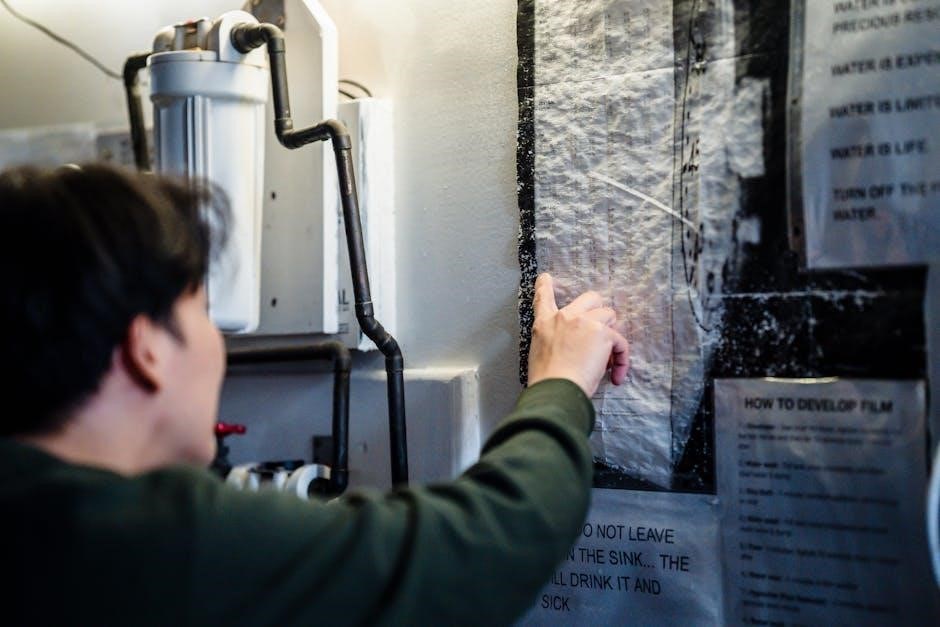The ASVAB Mechanical Comprehension Test evaluates your understanding of basic mechanical principles, forces, and devices. It is crucial for military roles requiring mechanical aptitude; Mastering this section ensures better career opportunities and improved problem-solving skills in technical fields. Key topics include forces, motion, energy, and simple machines. Prepare with study guides and practice tests to build confidence and achieve success.
What is the ASVAB Test?
The ASVAB (Armed Services Vocational Aptitude Battery) is a multiple-choice test used by the U.S. military to assess an individual’s aptitude for various career paths. It measures skills in areas like mechanical comprehension, general science, arithmetic reasoning, and more. The test helps determine eligibility for specific military roles and provides career guidance. With multiple sections, it evaluates a wide range of abilities, making it a critical tool for military placement and vocational counseling. Performing well on the ASVAB opens up opportunities for specialized training and advanced career options.
Importance of the Mechanical Comprehension Section
The Mechanical Comprehension section is vital for assessing mechanical aptitude, crucial for military roles requiring technical skills. It evaluates understanding of principles like forces, motion, and energy. A high score enhances career opportunities in engineering, mechanics, and technical fields. Strong performance demonstrates problem-solving abilities and hands-on aptitude, essential for specialized training and advanced roles. This section is a key factor in determining eligibility for certain military positions, making it a critical area of focus for ASVAB preparation and career advancement in technical fields.
Key Topics Covered in the Mechanical Comprehension Section
The Mechanical Comprehension section covers essential mechanical principles, including forces, motion, and energy. It tests understanding of tension, compression, and fluid dynamics. Basic concepts like levers, pulleys, and gears are also emphasized. The section includes questions on gravity, friction, and thermodynamics. Additionally, it assesses knowledge of simple machines and mechanical tools, ensuring a well-rounded understanding of mechanical systems. Mastery of these topics is crucial for success on the test and for related military roles.

Fundamental Principles of Mechanics

Mechanics involves the study of motion, forces, and energy; Newton’s laws govern motion, while gravity and friction affect object behavior. Understanding these principles is foundational for mechanical comprehension and problem-solving.
Newton’s Laws of Motion
Newton’s laws form the cornerstone of mechanics. The First Law states that an object remains at rest or in motion unless acted upon by an external force. The Second Law relates force, mass, and acceleration, expressed as ( F = ma ). The Third Law explains that every action has an equal and opposite reaction. Understanding these principles is essential for solving problems involving motion, forces, and interactions in the ASVAB Mechanical Comprehension section.
Understanding Gravity and Friction
Gravity is a universal force pulling objects toward the Earth, measured in newtons. Friction is the resistance between surfaces in contact, preventing slipping. There are two types: kinetic (during motion) and static (preventing motion). Friction depends on surface roughness and pressure. Mastering these concepts is vital for solving ASVAB problems involving forces, motion, and energy. Understanding how gravity and friction interact helps in analyzing real-world mechanical systems and predicting outcomes in various scenarios.
Basic Concepts of Energy and Work
Energy is the capacity to perform work, available in forms like kinetic (energy of motion) and potential (stored energy). Work is defined as force applied over a distance, calculated as Work = Force × Distance. Understanding the relationship between energy and work is crucial for analyzing mechanical systems. Energy transfer and transformation are key concepts, as systems often involve converting energy types (e.g;, potential to kinetic). Efficiency measures the ratio of useful energy output to energy expended. Mastering these principles aids in solving ASVAB questions involving motion, forces, and mechanical systems.

Types of Forces and Their Interactions
Forces like tension, compression, and friction act on objects, influencing motion and stability. Understanding their interactions is essential for analyzing mechanical systems and solving ASVAB questions effectively.
Tension and Compression Forces
Tension and compression forces are fundamental in mechanics. Tension occurs when a force stretches an object, like a rope pulled from both ends. Compression is a squeezing force, such as weight on a column. Understanding these forces is critical for analyzing structures and machinery. For example, tension in wires and compression in beams are essential in construction. Balancing these forces ensures stability and prevents failure. Mastering this concept aids in solving ASVAB questions about mechanical systems and material strength.
Fluid Pressure and Dynamics
Fluid pressure and dynamics involve the behavior of liquids and gases in motion or at rest. Pressure is force per unit area, often measured in pounds per square inch (PSI). Fluid dynamics studies flow rates, velocity, and energy transfer. Key principles include Bernoulli’s Equation and Pascal’s Law. Understanding these concepts helps in solving problems related to hydraulics, pneumatics, and fluid-powered systems. ASVAB questions may cover pressure measurement, flow calculations, and the differences between static and dynamic pressure. Mastery of these topics is essential for engineering and mechanical roles.
Understanding Levers, Pulleys, and Gears
Levers, pulleys, and gears are fundamental mechanical devices that simplify work. A lever amplifies force through a fulcrum, with three classes: first, second, and third. Pulleys change the direction of force, with types like fixed and movable. Gears transmit motion between rotating parts, with spur, bevel, and worm gears being common. These devices are essential in machinery and tools, and understanding their operation is critical for solving ASVAB mechanical problems. Practice questions often involve calculating mechanical advantage and efficiency in these systems.

Mechanical Devices and Tools
Common mechanical tools include wrenches, pliers, screwdrivers, hammers, saws, drills, and sanders. Understanding their functions and proper use is essential for solving ASVAB mechanical problems. Mastering principles like mechanical advantage, torque, and efficiency enhances problem-solving skills and ensures effective preparation for the test.
Principles of Simple Machines
Simple machines are fundamental devices that simplify tasks by amplifying force or changing its direction. The six basic types include levers, pulleys, wheels and axles, inclined planes, wedges, and screws. Each machine operates on the principle of mechanical advantage, which reduces the effort needed to perform work. Understanding how these machines manipulate force and motion is crucial for the ASVAB Mechanical Comprehension Test. Familiarizing yourself with their applications and efficiency will enhance your ability to solve complex problems effectively. Mastering these principles is essential for success in mechanical-related questions.
Common Mechanical Tools and Their Uses
Identifying and understanding common mechanical tools is vital for the ASVAB Mechanical Comprehension Test. Tools like wrenches, screwdrivers, and hammers are essential for applying force effectively. Pliers and punches are used for gripping and marking materials. Understanding the purpose of each tool, such as torque wrenches for precise force application, is crucial. Familiarizing yourself with tool diagrams and their functions will enhance your problem-solving abilities. This knowledge is key to answering questions about tool usage and mechanical operations accurately. Practice identifying tools to improve your test performance.

Fluid Dynamics and Thermodynamics
Understanding fluid dynamics and thermodynamics is crucial for the ASVAB Mechanical Comprehension Test. These sections cover principles of fluid pressure, flow, heat transfer, and energy exchange, essential for mechanical problem-solving.
Understanding Fluid Pressure and Flow
Fluid pressure and flow are fundamental concepts in mechanics, crucial for the ASVAB Mechanical Comprehension Test. Fluid pressure refers to the force exerted per unit area by a fluid at equilibrium, while flow relates to the movement of fluids. Bernoulli’s principle explains how pressure and velocity are inversely related in flowing fluids. Pascal’s law describes how pressure applied to a confined fluid is transmitted uniformly. Understanding these principles is vital for solving problems involving hydraulics, pumps, and fluid-based systems, common in military and technical applications.
Basics of Thermodynamics and Heat Transfer
Thermodynamics is the study of heat, temperature, and energy transfer. The first law of thermodynamics states that energy cannot be created or destroyed, only converted. The second law introduces entropy, a measure of disorder. Heat transfer occurs through conduction, convection, and radiation. Understanding these principles is essential for analyzing engines, refrigeration systems, and energy efficiency in mechanical systems. Key concepts include thermal equilibrium, specific heat capacity, and the relationship between heat, work, and energy. Mastering these basics is crucial for solving thermodynamics-related problems on the ASVAB test.

Practice Tests and Sample Questions
Practice tests and sample questions are essential for assessing readiness and improving problem-solving skills. They cover various mechanical topics, helping you identify strengths and areas needing review. Timed tests enhance time management, while detailed explanations clarify complex concepts. Regular practice builds confidence and ensures familiarity with the test format, maximizing your score potential.
How to Use Practice Tests Effectively
Practice tests are a powerful tool for ASVAB Mechanical Comprehension preparation. Start by simulating real test conditions, including time limits, to build stamina. After completing a test, review each question thoroughly, focusing on incorrect answers. Identify weak areas and create a targeted study plan. Regularly track progress to measure improvement. Use detailed explanations to grasp concepts and avoid repeating mistakes. Consistent practice ensures familiarity with question formats and boosts confidence. By integrating practice tests into your routine, you refine problem-solving strategies and enhance test-taking skills.
Sample Questions and Detailed Explanations
Sample questions and detailed explanations are essential for mastering the ASVAB Mechanical Comprehension Test. These resources provide real-world examples of test questions, covering topics like levers, pulleys, and fluid dynamics. Each question is paired with a thorough explanation, breaking down complex concepts into understandable parts. By analyzing these, you can identify knowledge gaps and focus your study efforts. Practicing with sample questions improves problem-solving skills and builds familiarity with the test format. Regular review of explanations ensures a deeper understanding of mechanical principles, enhancing overall test readiness and confidence.

Study Tips and Strategies

Focus on understanding basic mechanical principles, use visual aids, and practice regularly. Utilize sample questions to identify weaknesses and improve problem-solving skills. Manage your time effectively during study sessions to ensure comprehensive preparation.
Effective Study Techniques for Mechanical Comprehension
Master mechanical concepts by breaking them into simple components. Use flashcards to memorize key terms and principles. Practice with sample questions to improve problem-solving skills. Focus on understanding forces, motion, and energy. Visualize mechanical systems and their interactions. Dedicate time to reviewing formulas and their applications. Utilize study guides and online resources for structured learning. Engage in hands-on activities or simulations to reinforce theoretical knowledge. Prioritize weak areas and allocate more study time to them. Consistency and active learning are key to excelling in this section.

Time Management and Test-Taking Strategies
Allocate time wisely during the test to answer all questions. Skim through easier questions first and return to challenging ones later. Eliminate incorrect options to increase the chances of selecting the right answer. Practice under timed conditions to improve speed and accuracy. Stay calm and read each question carefully to understand what is being asked. Avoid spending too much time on a single question, as it may impact your ability to complete the test. Use practice tests to refine your strategy and build confidence.
Mastering the ASVAB Mechanical Comprehension Test requires dedication and consistent practice. Use study guides, practice tests, and effective strategies to ensure success. Good luck!
Final Tips for Success
To excel on the ASVAB Mechanical Comprehension Test, focus on consistent practice and review. Use study guides and practice tests to identify weak areas and improve. Understand key principles like forces, motion, and energy rather than memorizing formulas. Manage your time wisely during the test, and review mistakes to avoid repeating them. Stay calm, approach each question logically, and maintain a positive mindset. With dedication and strategic preparation, you can achieve a high score and unlock career opportunities in the military. Good luck!



